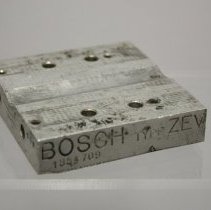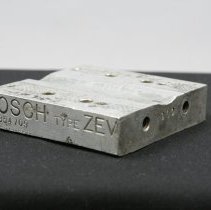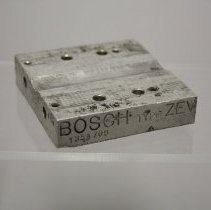Object Record
Images



Metadata
Object Name |
Magneto |
Catalog Number |
2014.fic.642 |
Description |
A cap from a Bosch Type ZEV Magneto. A square block of aluminum. The bottom has 8 holes (4 threaded) along the top and bottom and the center is machined out. Two of the sides have 2 holes each threaded. The front side reads, "Bosch Type ZEV 1354709 New York" Stamped and the back has the Patent information stamped. |
Year Range from |
1947 |
Year Range to |
1948 |
Provenance |
This artifact was donated by former La Crosse mayor Joseph Verchota. With the object was a slip of paper saying it came from an airplane crash that occurred in the La Crosse area around 1947. On August 1948 Northwest Airlines Flight 421 crashed outside of Winona, MN on the Wisconsin side of the river after last reporting in over La Crosse. The aircraft was a Martin 2-0-2, which had 2 Pratt & Whitney R-2800 Double Wasp Propeller engines. Some of the Pratt & Whitney engines used the Bosch Type ZEV Magneto. At the time it was the 9th deadliest aircraft crash in the world and it made the national news. |
Material |
Metal |
Dimensions |
H-0.75 W-2.75 L-3 inches |
Length (in) |
3.000 |
Height (in) |
0.750 |
Width (in) |
2.750 |
People |
Verchota, Joseph |
Subjects |
Transportation |
Notes |
Exact transcription of note: Donated by Joseph Verchota. Part of the engine of an air - craft that crashed here. Featured in Things that Matter "On August 29 1948, the Upper Midwest was going through a heat wave. Weather reports indicated that the day would be nearly clear with a few showers in the La Crosse area. This is the report that Northwest Airlines Flight 421, flying from Chicago to Minneapolis, received. But, later, an unexpected storm was brewing. At around 5:00 pm people in Winona were staring at the sky, watching a growing thunderstorm approach. The thunderstorm grew more intense as it came towards them, with increasing thunder and lightening that was not a part of the initial forecast. It was on this day that Northwest Airlines Flight 421 crashed just outside of Winona. The airplane was a Martin 2-0-2, and it was a little under a year old. It was a newer, more modern model, and it contained extras such as reading lights and air conditioning. The flight had an experienced pilot and co-pilot: Captain Robert Johnson and David Brenner. The pilot had flown more than five thousand hours, and the copilot, a native of La Crosse, served as a pilot during WWII. A total of 33 passengers boarded the plane expecting to land in Minneapolis a couple hours later. It departed from Chicago at 3:50 pm. No issues occurred at take-off, and the plane flew to its planned altitude of 8,000 feet as it went over Wisconsin. A little after an hour into the flight the Martin 2-0-2 aircraft reported its position, which was over La Crosse. This would be the airplane’s last check-in, and the pilot’s voice was calm. The plane gained permission to descend a thousand feet. The plane descended, continued its course, and encountered the unexpected storm. According to eyewitnesses, the plane was spotted below some of the clouds before flying into the edge of the storm clouds. Within seconds the bystanders witnessed the plane falling from the sky. Local farmers claimed the plane barrel-rolled out of the sky even though winds were light. Winona patrolman Ed Hittner responded to the call of the fallen flight. He waded down into the water himself after finding a wing in a marsh. He met up with a man named Jack Volkel, another pilot, and he recognized the type of plane and understood the possible significance. Immediately, Volkel went to check if any flights were missing. The plane was mainly torn into four pieces. Parts of the wreckage were found as far as seven miles away from the crash site in a ballpark in Winona. It has been estimated that as many as 20,000 came to the crash scene and offered aid. All of the 33 passengers and four crewmembers on the flight died in the crash. At first most guessed the plane had been struck by lightening, but the Martin 2-0-2 aircraft actually had a structural flaw in its left wing, causing the plane to crash less than five miles northwest of Winona. After the crash, the Civil Aeronautics Board investigated the flight, and discovered the crash was caused by a series of fatigue cracks in the wing. The Board then requested all Martin 2-0-2 planes to fly at lower speeds and have more frequent inspections. This object is the cap from a Bosch Type ZEV Magneto, which was part of the plane that crashed outside of Winona decades ago. A magneto is a generator that uses magnets to create an alternating current. The Martin 2-0-2 aircraft had two Pratt & Whitney R-2800 Double Wasp Propeller engines. Many of the Pratt & Whitney engines used the Bosch Type ZEV Magneto. The site of a violent event produces a dreadful fascination in people, which brings a powerful sense of the brevity of life. Many of the visitors to the crash site might have taken away small souvenirs such as this magneto. They were relics saved by someone to remind them of the terrible event they witnessed. LCHS records state this artifact came from Joseph Verchota, who was the mayor of La Crosse from 1923-1928, 1931-1934, and 1939-1946. Verchota himself died in January, 1949, just 4 months after the plane crash, so it is likely the magneto was among the objects donated by his estate. We have no way of knowing how he possessed it." This article was originally published in the La Crosse Tribune. Title: The Magneto from Flight 421 Author: Ivy King Publish Date: August 19, 2017 |